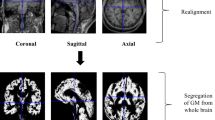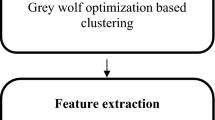Abstract
The early diagnosis of Parkinson’s disease (PD) is important to reduce deaths due to this disease. Images of patients with PD obtained through magnetic resonance imaging (MRI) show gray matter, white matter, and cerebrospinal fluids; images of these components provide physicians with important information to determine the severity of the disease. Therefore, methods for segmenting these regions in images have been employed. However, difficulties have been encountered in the segmentation of the PD MRI images owing to the unclear boundaries between the gray matter and white matter and the regions being contained in homogeneous and unclear structures. Therefore, we propose a hybrid wavelet k-means clustering (KMC) and fuzzy median filter (FMF) method. First, detailed information from the MRI images was extracted using discrete wavelet transform; these images were enhanced by increasing the pixel values. The enhanced images were then fed into the KMC model for segmentation. Finally, the segmented images were input into the FMF for removing uncertainty and noise. This method can also be used for segmenting the MRI images of other diseases such as tuberous sclerosis (TBS) and atrial fibrillation (AF). The results of a qualitative and quantitative evaluation conducted using an open-source benchmark dataset and a clinical dataset were presented. The peak signal-to-noise ratio, structural similarity, and mean-squared error were used to compare the efficiency of the proposed method with that of other segmentation methods. The results proved that the proposed method can assist in the early detection of PD, TBS, and AF from MRI.






Source images, b ground truth, and segmented images using the c Otsu method, d FCM, e KMC, f PNN, g neutrosophic, h deep learning, and i proposed method

Source images, b ground truth, and segmented images using the c Otsu method, d FCM, e KMC, f PNN, g neutrosophic, h deep learning, and i proposed method
Similar content being viewed by others
References
Hong, J., Park, B.Y., Lee, M.J., Chung, C.S., Cha, J., Park, H.: Two-step deep neural network for segmentation of deep white matter hyper intensities in migraineurs. Comput. Methods Progr. Biomed. 183(105065), 1–9 (2020)
Jin, X., Chen, G., Hou, J., Jiang, Q., Zhou, D., Yao, S.: Multimodal sensor medical image fusion based on nonsubsampled shearlet transform and S-PCNNs in HSV space. Signal Process. 153, 379–395 (2018)
Yi, J., Wu, P., Jiang, M., Huang, Q., Hoeppner, D.J., Metaxas, D.N.: Attentive neural cell instance segmentation. Med. Image Anal. 55, 228–240 (2019)
Drozdzal, M., Chartrand, G., Vorontsov, E., Shakeri, M., Di Jorio, L., Tang, A., Romero, A., Bengio, Y., Pal, C., Kadoury, S.: Learning normalized inputs for iterative estimation in medical image segmentation. Med. Image Anal. 44, 1–3 (2018)
Harris, G.J., Barta, P.E., Peng, L.W., Lee, S., Brettschneider, P.D., Shah, A., Henderer, J.D., Schlaepfer, T.E., Pearlson, G.D.: MR volume segmentation of gray matter and white matter using manual thresholding: dependence on image brightness. Am. J. Neuroradiol. 15(2), 225–230 (1994)
Portela, N.M., Cavalcanti, G.D., Ren, T.I.: Semi-supervised clustering for MR brain image segmentation. Expert Syst. Appl. 41(4), 1492–1497 (2014)
Menze, B.H., Jakab, A., Bauer, S., Kalpathy-Cramer, J., Farahani, K., Kirby, J., Burren, Y., Porz, N., Slotboom, J., Wiest, R., Lanczi, L.: The multimodal brain tumor image segmentation benchmark (BRATS). IEEE Trans. Med. Imaging 34(10), 1993–2024 (2014)
Xu, R., Wunsch, D.: Survey of clustering algorithms. IEEE Trans. Neural Netw. 16(3), 645–678 (2005)
Jain, A.K.: Data clustering: 50 years beyond K-means. Pattern Recogn. Lett. 31(8), 651–666 (2010)
Moftah, H.M., Azar, A.T., Al-Shammari, E.T., Ghali, N.I., Hassanien, A.E., Shoman, M.: Adaptive k-means clustering algorithm for MR breast image segmentation. Neural Comput. Appl. 24(7–8), 1917–1928 (2014)
Huang, Y.-P., Singh, P., Kuo, H.-C.: A hybrid fuzzy clustering approach for the recognition and visualization of MRI images of Parkinson’s disease. IEEE Access 8(1), 25041–25051 (2020)
Mangan, A.P., Whitaker, R.T.: Partitioning 3D surface meshes using watershed segmentation. IEEE Trans. Vis. Comput. Graph. 5(4), 308–321 (1999)
Otsu, N.: A threshold selection method from gray-level histograms. IEEE Trans. Syst. Man Cybern 9(1), 62–66 (1979)
Wu, H.S., Barba, J., Gil, J.: Iterative thresholding for segmentation of cells from noisy images. J. Microsc. 197(3), 296–304 (2000)
Chan, F.H., Lam, F.K., Zhu, H.: Adaptive thresholding by variational method. IEEE Trans. Image Process. 7(3), 468–473 (1998)
Mallat, S.G.: A theory for multiresolution signal decomposition: the wavelet representation. IEEE Trans. Pattern Anal. Mach. Intell. 11(7), 674–693 (1989)
Zhang, J., Liu, Q., Chen, Z.: A medical image segmentation method based on SOM and wavelet transforms. J. Commun. Comput. 2(5), 46–50 (2005)
Shree, N.V., Kumar, T.N.: Identification and classification of brain tumor MRI images with feature extraction using DWT and probabilistic neural network. Brain Inform. 5(1), 23–30 (2018)
Mohsen, H., El-Dahshan, E.S., El-Horbaty, E.S., Salem, A.B.: Classification using deep learning neural networks for brain tumors. Fut. Comput. Inform. J. 3(1), 68–71 (2018)
Harati, V., Khayati, R., Farzan, A.: Fully automated tumor segmentation based on improved fuzzy connectedness algorithm in brain MR images. Comput. Biol. Med. 41(7), 483–492 (2011)
Ren, T., Wang, H., Feng, H., Xu, C., Liu, G., Ding, P.: Study on the improved fuzzy clustering algorithm and its application in brain image segmentation. Appl. Soft Comput. 81(105503), 1–9 (2019)
Huang, Y.-P., Zaza, S., Chu, W.-J., Krikorian, R., Sandnes, F.E.: Using fuzzy systems to infer memory impairment from MRI. Int. J. Fuzzy Syst. 20(3), 913–927 (2018)
Huang, Y.-P., Basanta, H., Kang, E.Y.-C., Chen, K.-J., Hwang, Y.-S., Lai, C.-C., Cambell, J.P., Chiang, M.F., Chen, R.V. P., Kusaka, S., Fukushima, Y., Wu, W.-C.: Automated detection of ROP early stages using deep convolution neural network. Br. J. Ophthalmol. 1–5 (2020)
Huang, Y.-P., Vadloori, S., Chu, H.-C., Kang, E.Y.-C., Wu, W.-C., Kusaka, S., Fukushima, Y.: Deep learning models for automated diagnosis of retinopathy of prematurity in preterm infants. Electronics 1444, 1–16 (2020)
Huang, Y.-P., Basanta, H.: Bird image retrieval and recognition using a deep learning platform. IEEE Access 7(1), 66980–66989 (2019)
Jha, D., Riegler, M.A., Johansen, D., Halvorsen, P., Johansen, H.D.: DoubleU-Net: a deep convolutional neural network for medical image segmentation. arXiv preprint arXiv:2006.04868, Jun 2020
Lundervold, A.S., Lundervold, A.: An overview of deep learning in medical imaging focusing on MRI. Zeitschrift für Medizinische Physik 9(2), 102–127 (2019)
https://ida.loni.usc.edu/login.jsp. Accessed 15 Aug 2020
Wang, Z., Bovik, A.C., Sheikh, H.R., Simoncelli, E.P.: Image quality assessment: from error visibility to structural similarity. IEEE Trans. Image Process. 13(4), 600–612 (2004)
Rai, H.M., Chatterjee, K.: Hybrid adaptive algorithm based on wavelet transform and independent component analysis for denoising of MRI images. Measurement 144, 72–82 (2019)
Hartigan, J.A.: Clustering Algorithms. Wiley, New York (1975)
Ng, H.P., Ong, S.H., Foong, K.W., Goh, P.S., Nowinski, W.L.: Medical image segmentation using k-means clustering and improved watershed algorithm. In: Proc. of IEEE Southwest Symp. on Image Analysis and Interpretation, Denver, CO, USA, pp.61–65, (2006)
Vijay, J., Subhashini, J.: An efficient brain tumor detection methodology using K-means clustering algorithm. In: Proc. of Int. Conf. on Communication and Signal Processing, Melmaruvathur, India, pp.653–657 (2013)
Jiang, Q., Jin, X., Lee, S.J., Yao, S.: A novel multi-focus image fusion method based on stationary wavelet transform and local features of fuzzy sets. IEEE Access 5, 20286–20302 (2017)
Rashno, E., Minaei-Bidgoli, B., Guo, Y.: An effective clustering method based on data indeterminacy in neutrosophic set domain. Eng. Appl. Artif. Intell. 89, 103411 (2020)
Acknowledgements
This study was funded in part by the Ministry of Science and Technology, Taiwan, under Grant MOST108-2221-E-027-111-MY3, in part by the joint project between the National Taipei University of Technology and the Chang Gung Memorial Hospital under Grant NTUT-CGMH-106-05, and in part by the National Taipei University of Technology International Joint Research Project, NTUT-IJRP-109-03.
Author information
Authors and Affiliations
Corresponding authors
Rights and permissions
About this article
Cite this article
Huang, YP., Bhalla, K., Chu, HC. et al. Wavelet K-Means Clustering and Fuzzy-Based Method for Segmenting MRI Images Depicting Parkinson’s Disease. Int. J. Fuzzy Syst. 23, 1600–1612 (2021). https://doi.org/10.1007/s40815-021-01053-6
Received:
Revised:
Accepted:
Published:
Issue Date:
DOI: https://doi.org/10.1007/s40815-021-01053-6




